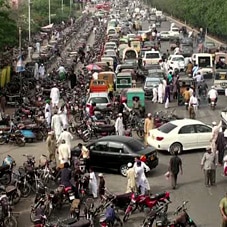
Pakistan Institute of Development Economics
- Home
Our Portals
MenuMenuMenuMenuMenuMenuMenu - ResearchMenuMenuMenuMenuMenuMenuMenu
- Discourse
- The PDR
- Our Researchers
- Academics
- Degree Verification
- Thesis Portal
- Our Portals

Bikes, Density and Cars
Lord Keynes in a famous statement said that “Practical men who believe themselves to be quite exempt from any intellectual influence, are usually the slaves of some defunct economist. Madmen in authority, who hear voices in the air, are distilling their frenzy from some academic scribbler of a few years back”It is not surprising to know that nowhere is this statement more true than in Pakistan. We are really a sucker for this so called “best practice” never even questioning the possibility that new thinking may have overtaken such “best practice”.
Now we are into designing the most expensive public transport system of metro-buses stretching 20+ miles across the city without thinking of options and without even a discussion on a proper feasibility. In a rush to build these we have generously committed public funds in a plethora of contracts that represent future guarantees and commitments of the exchequer.
Could there have been other approaches? This was never considered.
Before metrobuses, our leaders were enamored of underpasses and flyovers to facilitate cars to move across that suburban sprawls that we are developing. Once again you can see that these are ideas that were in vogue in the US and other advanced countries in the 60s. We did this 30 years later still listening to old ideas.
The urban sprawl and the huge road network of wide avenues flyovers and underpasses through generous use of public funds is a subsidy to cars and a tax on the poor. To see how, note that before policy started favoring sprawl and cars, the poor used bikes and walked. Now they cannot.Enrique Penelosa, the famous mayor of Bogota has shown that mobility is an important right for all in a city and public transport is an important part of it. Our leaders have started to appreciate this lesson. But again not the whole lesson.
Increasingly cities are learning that mobility is more than cars and metro-buses. Walking and bicycling are also mobility choices. But this will happen if a) cities are allowed to densify and b) the current policy of subsidizing cars and taxing bicycling and walking is discontinued.
Densifying will begin with discontinuation of the current sprawl model where single family homes spread into the countryside, destroying agriculture and the environment. It means allowing for mixed use, commercial development of offices and shopping malls and flat based living. It also means a liberal building code that does not disfavor high rise and commercial development. It also means a city development administration friendly to construction. The current model favors the car as a mode of transport in our cities. The expense of the new metro-bus routes has been raised because of the need to provide space to cars. Otherwise it was easy to simply ban cars from Ferozepur Road in Lahore and use it only for buses. No big pillars or construction.
With densification, a lot of people can choose walking and bicycles as a mode of transport. But not if we keep the current car-favoring model in place. City administration’s 50 year romance with the car has to give.I have argued for long now that we need a complete paradigm shift in our approach to city management. Along with densification, we need a car policy. Such policy would be based on pricing the use of the car to discourage use especially in denser, more congested parts of the city. The following principles would be used in making this car policy.
· Congestion fee over the most dense mixed use area which should be attracting the most traffic.
· The elimination of free or cheap parking in a big city like Lahore. Instead a graduated (distance from the center) metered electronic parking system should be developed.
· Traffic flow should be studied for one way systems to reduce congestion and also to find space for sidewalks and bicycle lanes.
· Sidewalks and bicycle lanes should be given priority everywhere to induce people to take these healthy alternatives. Motorists crossing over into those areas would be heavily penalized.
· With densification, zoning laws should allow more neighborhood commerce for increased use of walking and bikes to be used.
· Technology should be used for fee and fine collection and through cameras for enforcement. This could be a reasonable source of revenue for the city.Somehow the powers that be cannot leapfrog into the modern era taxing us and our cities. The sprawl from Kasur to Sialkot is wasteful in every way. The Lahore smog has robbed us of our lovely winter sun and jammed our airports and our streets. Jobs and output are lost as is agricultural land, while we build in the most energy intensive manner. Yet the old mindset remains fixated on cars and their space leaving little room for people and community.,
Changing the paradigm as suggested here, urban renewal will start. Construction industry will get a huge boost and we may even begin to see that symbol of development—the tower crane– in our cities. It will also lead to a more inclusive growth as the poor will find space in our cities in flats. And they will be able to walk and use bicycles as cars are priced right.More than likely new services—such as delivery, carpooling, even taxis– will develop, providing much needed employment to that worrisome youth bulge.
The Chief Minister Punjab agreed with the vision but could not persuade his officials to implement it. Can the media?
Download full PDF


